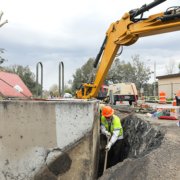San Diegans got a taste of winter weather Saturday.
“We were actually excited when we saw the rain,” said Forest Padilla, a San Diego resident.
The cold showers lasted throughout most of the day.
“It’s nice to have the rain every once in a while,” said Travis Robertson-Howell, a San Diego resident.
But it may be even nicer to have it a little more often. The latest drought map from the National Integrated Drought Information System showed much of the San Diego region is experiencing abnormally dry conditions.
Luckily it doesn’t appear to show drought in the area. The rest of the state isn’t so lucky. According to the map, drought exists in some way in approximately 95 percent of the state. The state was drought-free at this time last year.
“At this point in the winter it is still fairly early,” said Mike Lee, public affairs manager with the San Diego County Water Authority.
Lee says it’s too soon to raise concerns.
“Just a few storms can radically improve and change the water supply conditions in the snowpack in the mountains,” said Lee. “That can happen in February, sometimes in March, and even April.”
And even if we don’t get all the rain we need, he says the county has a back-up plan.
“Every five years we go through a rigorous planning process at the county water authority and with all of our member agencies across the region to ensure that even if we were to have three, four dry years in a row that we would still have enough safe reliable water to meet our region’s needs,” said Lee.
So for now, Lee says San Diegans can enjoy the wet weather as he expects more is to come.





